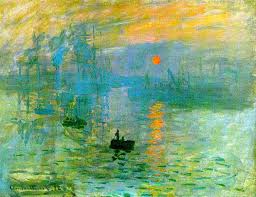Among my favourite selections as teaching pieces lie the works of Claude Debussy, Maurice Ravel, and Charles Griffes.
This blog post emerges after a great week of impressionistic music, and my attempts to briefly explain the inpressionist movement first in art, then in music. It is by no means scholarly, but meant to be a guide for my teenage pianists who are exposed to the wonder of impressionism for the first time (or second time, third time..).
Impressionism began in painting, and only then spilled into the world of music. Impressionism in music stretches roughly from 1890-1910. (some say earlier, 1870). To follow is a brief outline and description of impressionism in art, with some famous samples from both art and music.
Impressionism " is a 19th-century art movement that originated with a group of Paris-based artists.
Their independent exhibitions brought them to prominence during the 1870s and 1880s, in spite of harsh opposition from the conventional art community in France.
The term impressionist was first used by French art critic Louis Leroy in 1874 based on Monet's painting Impression, Sunrise. (see this painting below). Leroy found the term fitting to describe the loose, undefined and "unfinished" style that Monet and several other artists applied to their paintings.
Characteristics of Impressionist painting include relatively small, thin, yet visible brush strokes, open composition, emphasis on accurate depiction of light in its changing qualities (often accentuating the effects of the passage of time), common, ordinary subject matter, inclusion of movement as a crucial element of human perception and experience, and unusual visual angles. The development of Impressionism in the visual arts was soon followed by similar styles in other art forms that became known as impressionist music and impressionist literature."
In order to convey the movement and changing nature of a passing moment, the Impressionists used quick, broken brush strokes that were left without any further smoothing. This method allows the viewer to clearly see the traces of the brush and gives impressionist paintings an unfinished appearance. The Impressionists worked quickly, sometimes in one sitting, in order to capture the fleeting moment and to give their work a spontaneous feel.

Monet‑Impression_Sunrise_1872

Monet 1953

Vincent Van Gogh Starry Night 1889 (which he painted while in an asylum)

Monet Water Lilies 1916-1923

Pierre- Auguste Renoir, Young Woman at the Piano 1875
Impressionism in music is a style of composition initiated by French composer Claude Debussy at the end of the 19th century.Elements often termed impressionistic include static harmony, emphasis on instrumental timbres that create a shimmering interplay of “colours,” melodies that lack directed motion, surface ornamentation that obscures or substitutes for melody, and an avoidance of traditional musical form. Common is quartal harmony, that is harmony abundant in 4th's and 5th's, and skyscraper chords.
Watch and listen to a Yale professor give a lecture on Impressionism:
http://oyc.yale.edu/music/musi-112/lecture-21
And next, the music:
Debussy Arabesque no 1 Francois-Joel Thiollier, piano
Arabesque no 1, piano, Aldo Ciccolini
The White Peacock, Charles Griffes, pianist, Olga Samaroff
This blog post emerges after a great week of impressionistic music, and my attempts to briefly explain the inpressionist movement first in art, then in music. It is by no means scholarly, but meant to be a guide for my teenage pianists who are exposed to the wonder of impressionism for the first time (or second time, third time..).
Impressionism began in painting, and only then spilled into the world of music. Impressionism in music stretches roughly from 1890-1910. (some say earlier, 1870). To follow is a brief outline and description of impressionism in art, with some famous samples from both art and music.
Impressionism " is a 19th-century art movement that originated with a group of Paris-based artists.
Their independent exhibitions brought them to prominence during the 1870s and 1880s, in spite of harsh opposition from the conventional art community in France.
The term impressionist was first used by French art critic Louis Leroy in 1874 based on Monet's painting Impression, Sunrise. (see this painting below). Leroy found the term fitting to describe the loose, undefined and "unfinished" style that Monet and several other artists applied to their paintings.
Characteristics of Impressionist painting include relatively small, thin, yet visible brush strokes, open composition, emphasis on accurate depiction of light in its changing qualities (often accentuating the effects of the passage of time), common, ordinary subject matter, inclusion of movement as a crucial element of human perception and experience, and unusual visual angles. The development of Impressionism in the visual arts was soon followed by similar styles in other art forms that became known as impressionist music and impressionist literature."
In order to convey the movement and changing nature of a passing moment, the Impressionists used quick, broken brush strokes that were left without any further smoothing. This method allows the viewer to clearly see the traces of the brush and gives impressionist paintings an unfinished appearance. The Impressionists worked quickly, sometimes in one sitting, in order to capture the fleeting moment and to give their work a spontaneous feel.
Monet‑Impression_Sunrise_1872

Monet 1953

Vincent Van Gogh Starry Night 1889 (which he painted while in an asylum)

Monet Water Lilies 1916-1923

Pierre- Auguste Renoir, Young Woman at the Piano 1875
Impressionism in music is a style of composition initiated by French composer Claude Debussy at the end of the 19th century.Elements often termed impressionistic include static harmony, emphasis on instrumental timbres that create a shimmering interplay of “colours,” melodies that lack directed motion, surface ornamentation that obscures or substitutes for melody, and an avoidance of traditional musical form. Common is quartal harmony, that is harmony abundant in 4th's and 5th's, and skyscraper chords.
Watch and listen to a Yale professor give a lecture on Impressionism:
http://oyc.yale.edu/music/musi-112/lecture-21
And next, the music:
Debussy Arabesque no 1 Francois-Joel Thiollier, piano
Arabesque no 1, piano, Aldo Ciccolini
The White Peacock, Charles Griffes, pianist, Olga Samaroff